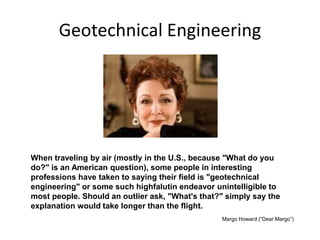The Basic Principles Of Geotheta
The Basic Principles Of Geotheta
Blog Article
The 2-Minute Rule for Geotheta
Table of ContentsGeotheta Fundamentals ExplainedGeotheta for BeginnersSome Known Factual Statements About Geotheta The Buzz on GeothetaGeotheta Things To Know Before You Buy

They conduct site examinations, gather samples, do lab examinations, and analyze information to assess the suitability of the ground for building and construction projects - Tailings Engineer. Based upon their findings, geotechnical engineers supply recommendations for foundation layout, incline security, preserving frameworks, and mitigation of geotechnical risks. They work together with various other specialists, such as architects, structural engineers, and building and construction teams, to ensure that geotechnical considerations are integrated right into the overall project design and implementation
By examining the behavior and properties of soil and rock, they can determine prospective geotechnical dangers such as landslides, dirt negotiation, or slope instability. Their knowledge aids protect against failings or mishaps that can threaten lives and residential or commercial property. Below are some detailed tasks and obligations of a geotechnical designer: Site Examination: Geotechnical engineers conduct site examinations to gather data on subsurface problems.
They analyze the data to understand the residential or commercial properties and habits of the soil and rock, including their stamina, permeability, compaction attributes, and groundwater conditions. Geotechnical Evaluation and Style: Geotechnical designers evaluate the data collected throughout website investigations to analyze the security and suitability of the website for building and construction jobs. They perform geotechnical computations and modeling to evaluate variables such as birthing capability, settlement, incline security, lateral earth stress, and groundwater circulation.
Geotheta Can Be Fun For Everyone
Foundation Design: Geotechnical designers play a crucial duty in developing structures that can securely support the desired structure. They assess the dirt conditions and tons demands to establish the appropriate structure kind, such as shallow structures (e.g., grounds), deep foundations (e.g (https://www.goodreads.com/user/show/180594840-ian-hammond)., heaps), or specialized methods like soil enhancement. They think about elements such as settlement restrictions, birthing capability, and soil-structure interaction to create ideal foundation designs
They assess building and construction strategies, display website tasks, and conduct area inspections to verify that the design suggestions are followed. If unanticipated geotechnical issues arise, they analyze the situation and provide referrals for removal or adjustments to the layout. Danger Assessment and Reduction: Geotechnical engineers assess geotechnical threats and dangers connected with the project site, such as landslides, liquefaction, or soil disintegration.

Collaboration and Interaction: Geotechnical engineers function carefully with other professionals included in a task, such as architects, architectural engineers, and building groups. Efficient communication and collaboration are vital to integrate geotechnical considerations right into the general task style and building and construction procedure. Geotechnical engineers offer technological knowledge, answer inquiries, and ensure that geotechnical demands are satisfied.
Getting My Geotheta To Work
Below are some kinds of geotechnical designers: Foundation Designer: Foundation designers specialize in developing and basics evaluating foundations for structures. They examine the soil problems, lots needs, and website qualities to establish one of the most appropriate foundation kind and layout, such as superficial structures, deep foundations, or specialized methods like pile structures.
They evaluate the aspects affecting slope security, such as soil homes, groundwater conditions, and slope geometry, and develop approaches to avoid slope failures and alleviate risks. Quake Designer: Earthquake engineers specialize in analyzing and designing frameworks to stand up to seismic forces. They analyze the seismic danger of a website, review soil liquefaction potential, and create seismic layout requirements to make certain the safety and strength of structures during quakes.
They execute field screening, collect samples, and examine the gathered data to identify the dirt buildings, geologic formations, and groundwater problems at a site. Geotechnical Instrumentation Engineer: Geotechnical instrumentation designers concentrate on tracking and gauging the habits of soil, rock, and frameworks. They install and maintain instrumentation systems that keep an eye on aspects such as dirt settlement, groundwater levels, incline motions, and architectural variations to evaluate performance and give early warnings of potential problems.
The 9-Minute Rule for Geotheta
They perform tests such as triaxial examinations, combination examinations, direct shear examinations, and leaks in the structure examinations to collect data for geotechnical evaluation and design. Geosynthetics Engineer: Geosynthetics engineers focus on the layout and application of geosynthetic materials, such as geotextiles, geogrids, and geomembranes. They make use of these products to enhance soil security, strengthen slopes, supply water drainage services, and control disintegration.
They tend to be investigatory people, which means they're intellectual, introspective, and investigative. They are interested, methodical, logical, analytical, and logical. Several of them are additionally social, indicating they're kind, generous, participating, patient, caring, helpful, compassionate, sensible, and friendly. Does this seem like you? Take our complimentary profession examination to find out if geotechnical designer is one of your leading occupation matches.
In the office setting, geotechnical engineers utilize specialized software program tools to do computations, develop styles, and examine data. They prepare reports, testimonial job specifications, interact with clients and employee, and coordinate task activities. The office setup supplies a conducive environment for research study, analysis, and cooperation with other specialists associated with the task.
The 5-Second Trick For Geotheta
They often visit job websites to perform site investigations, examine geotechnical problems, and gather information for evaluation. These sees involve traveling to different places, often in remote or tough terrains. Geotechnical designers may perform soil sampling, conduct tests, and display construction activities to ensure that the geotechnical aspects of the job are being applied appropriately.
Geotechnical designers likewise work in specialized geotechnical laboratories. In these centers, they perform experiments, do examinations on soil and rock examples, and assess the design residential or commercial properties of the products. Geotechnical laboratory engineers function thoroughly in these environments, dealing with screening tools, operating instruments, and taping data. They team up with other research laboratory personnel to make certain precise and reliable screening outcomes.
Report this page